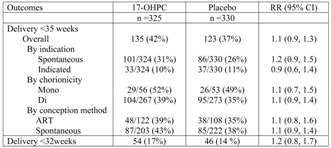Trial of 17-Hydroxyprogesterone Caproate (1y-OHPC) for the Prevention of Preterm Birth in Twins
SMFM 27th Annual Meeting 2007
view the interview video: Study Results of the Randomized Controlled Trial of 17-OHCP for the Prevention of Preterm Birth in Twins
Abstract
Objective: 17-OHPC has been shown to reduce the rate of recurrent preterm birth in singleton gestation. This study was undertaken to evaluate whether 17-OHPC would reduce the rate of preterm birth in twin gestation.
Study Design: We performed a randomized, double masked, placebo controlled trial in 14 centers. Healthy women with twin gestation and uniformly established gestational age were allocated to either weekly 250 mg intramuscular injections of 17-OHPC, or matching placebo, starting at 16-20 weeks and ending at 35 weeks' gestation. The primary study outcome was delivery prior to 35 weeks. Power was 90% to detect a 1/3 reduction in the primary outcome rate.
Results: Six hundred sixty one women were randomized. Baseline demographic data were similar in the two study groups including gestational age at randomization, maternal age, race, BMI, parity, prior preterm birth, smoking, marital status, chorionicity as diagnosed by ultrasound, and conception method. Six women (<1%) were lost to follow-up. Primary and selected secondary outcomes are provided in the table.

Conclusion: Treatment with 17-OHPC did not reduce the rate of preterm birth in women with twins.
References:
0002-9378/$ - see front matter
doi:10.1016/j.ajog.2006.10.003
American Journal of Obstetrics and Gynecology
Volume 195, Issue 6, Supplement S (December 2006)
S1E4: Dr. Kristina Adams-Waldorf: Pandemics, pathogens and perseverance
July 16th 2020This episode of Pap Talk by Contemporary OB/GYN features an interview with Dr. Kristina Adams-Waldorf, Professor in the Department of Obstetrics and Gynecology and Adjunct Professor in Global Health at the University of Washington (UW) School of Medicine in Seattle.
Listen
AI helps improve detection of congenital heart defects on prenatal ultrasounds
January 31st 2025AI-assisted software improves clinicians' detection of congenital heart defects in prenatal ultrasounds, enhancing accuracy, confidence, and speed, according to a study presented at SMFM's Annual Pregnancy Meeting.
Read More
Study shows a healthy prenatal diet could be upstream obesity prevention strategy
December 26th 2024"Our findings support the recommendation of a healthy diet based on the current guidelines (as measured by the HEI) during pregnancy, since it may reduce patterns of infant growth outside reference ranges."
Read More
